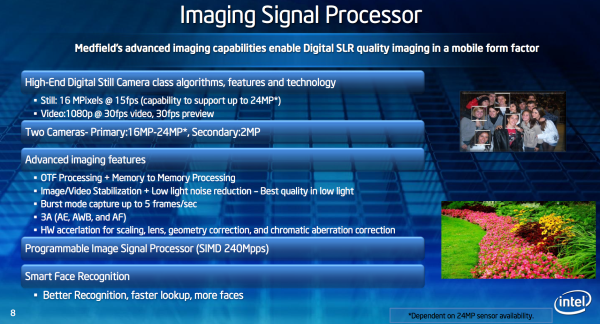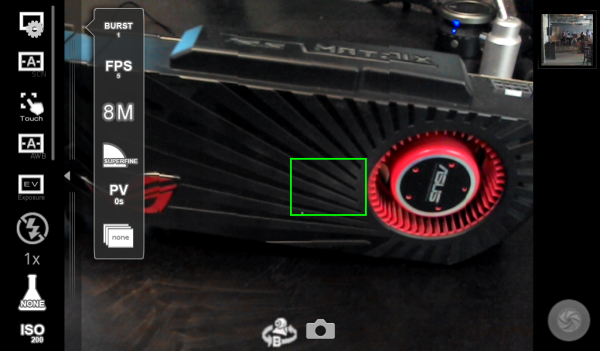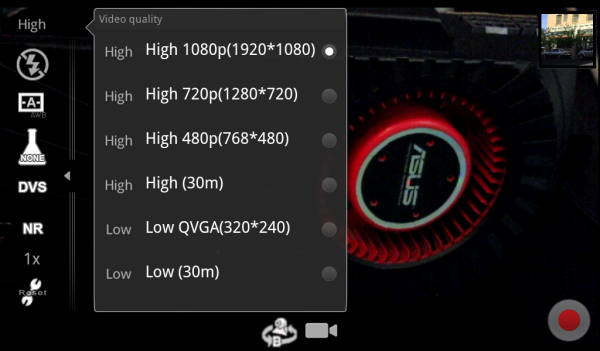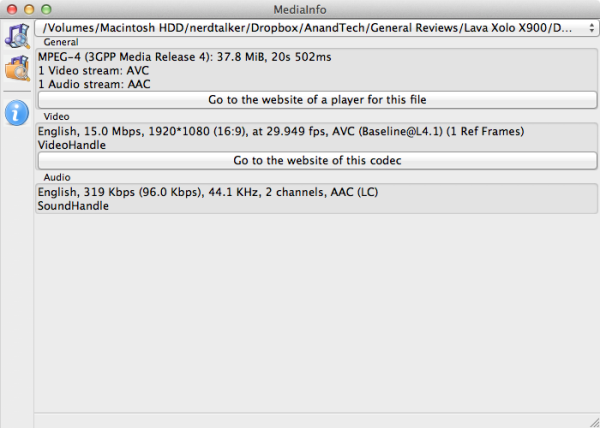Lava Xolo X900 Review - The First Intel Medfield Phone
by Brian Klug on April 25, 2012 6:00 AM ESTCamera is the other big axis of improvement with Medfield, as Intel has included a SiliconHive ISP with full support for up to 24 MP rear facing cameras and a 2 MP secondary camera. Intel acquired SiliconHive a while ago, and it has integrated their IP prominently inside the platform.
In addition all the features you need to support a smartphone camera are here, including AE, AWB, AF, lens shading and distortion correction, stabilization, and fixed pattern/dark noise subtraction. Intel is also quite proud of its burst functionality which enables up to 10 full size 8 MP images to be captured at up to 15 FPS.
I did some digging and found what CMOSes are being used in the Xolo X900 smartphone. The front facing camera is an Aptina mt9m114 1.3 MP 1/6“ CMOS with 1.9µm square pixels, and the rear facing camera is an Aptina mt9e013 8 MP 1/3.2” CMOS with 1.4µm pixels (3264 x 2448). The 8 MP rear facing system appears to possibly be from LiteOn. The optical system onboard is F/2.4 with 4.4mm focal length. The result is a thoroughly modern camera system that is up to par with what’s shipping in other devices right now. Interestingly enough, I can tell from poking around that Intel has tested the Medfield platform with a 14MP module as well.
The camera UI on the X900 is by far the most comprehensive of any smartphone I’ve encountered so far. The still shooting mode includes customization options for the burst mode and FPS, image capture size, compression level, and bracket modes in the top tab. Below that are scene modes (Auto, Sports, Portrait, Landscape, etc), focus modes (Auto, Infinity, Macro, Touch to focus), white balance (Auto, Incandescent, Daylight, etc), exposure, flash, color filters (None, Sepia, BW, Negative), ISO (100, 200, 400, 800), exposure time (1s to 1/500s), and auto exposure metering modes, phew. What’s really unique however are toggles under the happy face icon for advanced features like GDC (geometric distortion correction), XNR (extra noise reduction for low light), ANR (another noise reduction routine). These are usually things present in other ISPs, but I’ve never seen the option to play with them in any smartphone camera UI before. There are also some RAW options which, based on their labeling, I would assume allow you to save pre-Bayer demosaicing RAW data and YUV data, but I’m not sure where this data is stored after capture. Resetting the camera to defaults interestingly enough turns GDC, XNR, and ANR off, so it is in this mode that I captured sample images.
Burst mode works well, as does the camera UI. Images captured in burst mode are prefixed with BST instead of IMG when they’re stored, so you can tell the two apart later on the desktop. 8 MP images captured on SuperFine end up being just under 2 MB after JPEG compression.
To get to the bottom of still image quality, we turned to our regular set of evaluation tools, consisting of both photos taken in a fixed smartphone lightbox test scene with the lights on and off, with test charts (GMB color checker card, ISO12233, and distortion), and at our smartphone bench locations. I took these after resetting the camera to defaults, which again curiously disables GDC, XNR, and ANR. The result is some very strange higher order distortion in the chart (the chart is indeed flat and normal to the camera), but good spatial resolution in the ISO chart, I can see up to around 15 lp/ih in the vertical and 14 in the horizontal. White balance is a bit weird on the chart, but in the lightbox the white balance is pretty good. The X900 also illuminates the scene for focusing before taking the photo in the dark, which is something some smartphone OEMs are still not doing.
I’m pretty pleased with camera quality, it isn’t as good as some other smartphones that are out right now, but it’s very good. I suspect this is more a reflection of the optics (eg heavy distortion without geometrical correction) than ISP. I actually come away pretty impressed with all the options that have been made available, it’s obvious that lots of time and energy went into that part.
Video
The video capture UI unsurprisingly offers some of the same configuration options as the still shooting mode. Capture resolutions from QVGA to 1080p are offered, along with various MMS compatible settings like we’re used to seeing. The menu here also offers the ability to disable electronic video stabilization (DVS) and noise reduction (NR) which is awesome, especially since many find electronic video stabilization somewhat disconcerting. I disabled it for the test video since this results in the same behavior I saw with the Galaxy Nexus before Google ostensibly disabled it on the rear camera (but left it enabled on the front one). Anyhow, I’m grateful that the options are here, as the smartphone camera UI standard seems to be trending toward Apple’s minimalist tendency rather than exposing real options, but I digress.
To evaluate video capture quality on the X900, I took videos at the standard bench location at around the same time. The Medfield platform uses Imagination’s VDE285 video encoder. 1080p30 video recorded on the X900 is encoded at 15.0 Mbps H.264 Baseline with 1 reference frame. 720p30 video from the rear camera is encoded at around 8 Mbps with the same parameters, but interestingly enough front facing 720p30 video is encoded at 12Mbps. All three include 320 kbps AAC stereo audio.
Baseline H.264 is about par, but not the high profile that we’ve seen being done on other platforms like Exynos 4xxx or OMAP 4. Thankfully the baseline bitrate is good enough to produce good quality results, but again turning the encode parameters up a bit would enable better results with the same bitrate.
As we always do, I’ve uploaded the bench videos to YouTube and also made them available for direct download if you want to look at them without the transcode. Some small interesting points are how the videos are saved with a .3gp extension instead of the more common .mp4 (haven’t seen .3gp in a while, even if it’s acceptable), and also the 1080p video field of view is much narrower than the 720p field of view (clearly a center crop is being taken). Those notes aside, I have no issues with the 1080p video quality that’s produced, it looks good and has continuous auto focus. The 720p video has some weird decimation artifacts from downscaling, but nothing too bad, and 1080p maximum is usually what I scrutinize anyways.

























































106 Comments
View All Comments
jwcalla - Wednesday, April 25, 2012 - link
Well... it's competitive. Ultimately it'll come down to who has the most desirable device. We know Apple has it's iPhone... Samsung the Galaxy S... Motorola the Droid Razr, etc. Intel would need to get in with one of those companies and be a top device to be accepted. Nobody is going to buy it just because it's Intel. (Except the fanboys of course.)dt1561 - Wednesday, April 25, 2012 - link
Looks cool but nothing extraordinary.fic2 - Wednesday, April 25, 2012 - link
Not that it matters much but does the display use Gorilla Glass?snoozemode - Wednesday, April 25, 2012 - link
Sure it's fun that Intel finally has proven that x86/Atom works in a smartphone, but the overall result is just a very bland phone that's not superior at anything really. And with a price of $420.. Why would anyone buy this?A5 - Wednesday, April 25, 2012 - link
That's $420 with no contract. Considering the average carrier subsidy is $300-$400, this is a firmly mid-range device.fm123 - Thursday, April 26, 2012 - link
That is the price in India, which could be a completely different situation than other countries.sonicmerlin - Wednesday, April 25, 2012 - link
So given the nature of x86, can we self-install other compatible operating systems such as an x86 port of MeeGo? I'm *very* interested in using MeeGo outside of the N9. What about the x86 ICS image that Google makes available on its own website? Are there any customization or tweaking requirements, or can we install any new OS the same way we would install Linux or Windows on typical x86 hardware?That would be the ultimate advantage of an x86 phone or tablet, no?
Finally, the battery tests here don't discuss standby battery life. That's always been an issue with Android, and is why every other OS seems to have much longer battery life than Android. We don't use our smartphones the way these battery torture tests suggest we do. Could you please download an app like Battery Monitor Widget and indicate how many mA are being used during standby?
dcollins - Wednesday, April 25, 2012 - link
Installing a new OS requires supported drivers. MeeGo could be installed in theory if you ported the necessary drivers from Android. They are both Linux based, so this is theoretically possible, but it will require a lot of hacking and technical expertise. The Windows driver model is totally different so you would have to reverse engineer drivers from scratch. That's not going to happen.This fight is not about x86 versus ARM as ISAs. It's about Intel versus ARM licensees: who can develop a faster, lower power chip? If Intel does their job well, the ISA shouldn't matter to the end user.
sonicmerlin - Thursday, April 26, 2012 - link
I think you misunderstand. MeeGo already provides support for x86. Technically it's now "Tizen", but regardless it's been developed with both ARM and x86 in mind. My main question is whether we can self-install an x86 port of MeeGo (or Tizen) onto this phone?fteoath64 - Saturday, April 28, 2012 - link
¨This fight is not about x86 versus ARM as ISAs. It's about Intel versus ARM licensees¨It blows down to just that!. The cost efficiency of ARM chips will just kill any chance of Intel getting into this market. Just look at a completely built Android handset made in china with retina display for $119. A retailer selling it for $160-199 will made heaps, if billions of units are involved. All licenses of chips and Android are legit. Not copycat stuff. Genuine Cortex A9 licenses.
It comes at a time when having 4-5 suppliers of ARM chips have made the market very resilient, something a single supplier can never do. So I say to Intel again, get an ARM license and play this game the right way. You can innovate very nicely with competition, and you really need that competition to keep your edge.